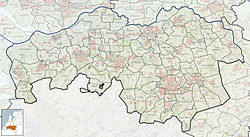
The Rijksmuseum is the national museum of the Netherlands dedicated to Dutch arts and history and is located in Amsterdam. The museum is located at the Museum Square in the borough of Amsterdam South, close to the Van Gogh Museum, the Stedelijk Museum Amsterdam, and the Concertgebouw.

North Brabant, also unofficially called Brabant, is a province in the south of the Netherlands. It borders the provinces of South Holland and Gelderland to the north, Limburg to the east, Zeeland to the west, and the Flemish provinces of Antwerp and Limburg to the south. The northern border follows the Meuse westward to its mouth in the Hollands Diep strait, part of the Rhine–Meuse–Scheldt delta. North Brabant had a population of about 2,626,000 as of January 2023. Major cities in North Brabant are Eindhoven, Tilburg, Breda, its provincial capital 's-Hertogenbosch, and Helmond
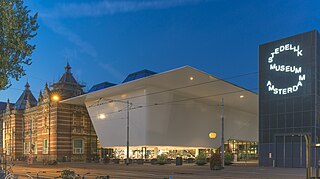
The Stedelijk Museum Amsterdam, colloquially known as the Stedelijk, is a museum for modern art, contemporary art, and design located in Amsterdam, Netherlands.

Breda is a city and municipality in the southern part of the Netherlands, located in the province of North Brabant. The name derived from brede Aa and refers to the confluence of the rivers Mark and Aa. Breda has 185,072 inhabitants on 13 September 2022 and is part of the Brabantse Stedenrij; it is the ninth largest city/municipality in the country, and the third largest in North Brabant after Eindhoven and Tilburg. It is equidistant from Rotterdam and Antwerp.
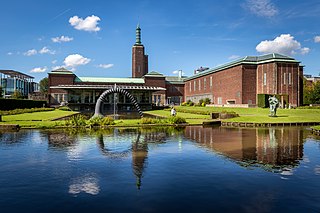
Municipal Museum Boijmans Van Beuningen is an art museum in Rotterdam in the Netherlands. The name of the museum is derived from its two most important donors, Frans Jacob Otto Boijmans and Daniël George van Beuningen. The museum is located at the Museumpark in the district Rotterdam Centrum, close to the Kunsthal and the Natural History Museum.
Leonard van Munster is a Dutch contemporary artist making Site-specific and Subject-specific work. He studied from 1992 to 1996 at the Gerrit Rietveld Academy in Amsterdam. This included an exchange programme to Parsons School of Art and Cooper Union in New York.

Pieter Dirk Brattinga was a Dutch graphic designer.
Mark Manders is a Dutch artist, currently living and working in Ronse, Belgium. His work consists mainly of installations, drawings and sculptures. He is probably best known for his large bronze figures that look like rough-hewn, wet or peeling clay. Typical of his work is also the arrangement of random objects, such as tables, chairs, light bulbs, blankets and dead animals.
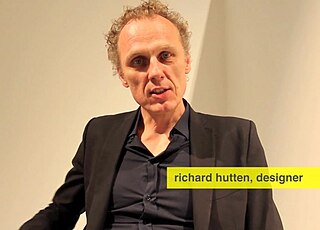
Richard G. J. Hutten is a Dutch industrial designer, art director, and artist who is active in furniture design, product design, interior design, and exhibition design.

The former Van Nelle Factory on the Schie in Rotterdam, is considered a prime example of the modernist and functionalist architecture. It has been a designated UNESCO World Heritage Site since 2014. Soon after it was built, prominent architects described the factory as "the most beautiful spectacle of the modern age" and "a poem in steel and glass".
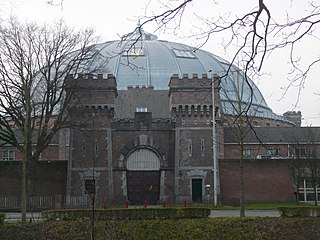
The Koepelgevangenis is a former prison in Breda, Netherlands, constructed in 1886, best known as the prison where convicted World War II collaborators and Nazi war criminals were housed.

Rosa Menkman is a Dutch art theorist, curator, and visual artist specialising in glitch art and resolution theory. She investigates video compression, feedback, and glitches, using her exploration to generate art works.

Anouk Kruithof is a transdisciplinary visual artist, who lives and works between Brussels, Belgium; Berlin, Germany; and Botopasi, Suriname.
Carolein Smit is a Dutch ceramic art sculptor whose work often includes animals or skeletons.

Harmen Liemburg is a Dutch graphic designer and screen printer. His work includes posters, publications and record sleeves, and is also applied in architecture.
Jacques Koeweiden is a Dutch graphic designer. He was a co-founder of Koeweiden Postma, a Dutch design and communication agency. Koeweiden's design for city branding of Amsterdam during de Coronation Day April 30, 2013 is a part of the collection at Stedelijk museum Amsterdam.
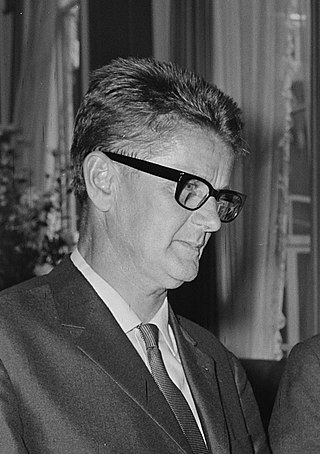
Casparus Bernardus Oorthuys, known as Cas Oorthuys, was a Dutch photographer and designer active from the 1930s until the 1970s.

Lily van der Stokker is a Dutch visual artist. She is known for her colorful site-specific painted installations incorporating words and decorative motifs that reference social realities and power dynamics.
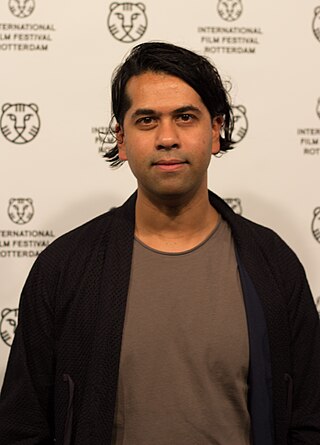
Melvin Moti is a Dutch contemporary video and media artist who examines neurological, scientific and historic processes in relation to visual culture. His work explores ideas of human experiences of spirituality, space, time and consciousness.
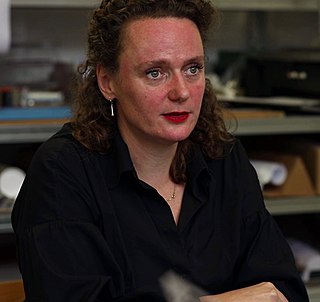
Hansje van Halem is a Dutch graphic designer and type designer. Her work is typified by geometric, repetitive, sometimes almost psychedelic patterns. She works at the intersection of text, illustration, pattern, colour, texture, distortions, interruptions, variations, symmetry, systematic approach and irregularities. Van Halem combines the more open rules of patterns with the tighter ruleset of typography and explores the boundaries of type design. She uses the viewer’s distance to the work to move at the edge of legibility and non-legibility. In her understanding background and type should become one layer. Important to her are the process itself, “playing” around and working with trial and error. Her commissions rather revolve around the creation of identities, whole covers and patterns than individual fonts.


